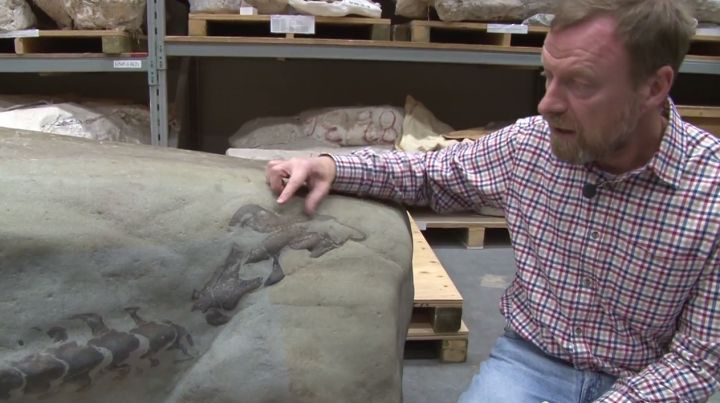DRUMHELLER, Alta. – Severe flooding in southwestern Alberta in 2013 may be responsible for two fishermen discovering the 80 million-year-old fossil of a possible new dinosaur species.

A 1,300-kilogram boulder the men found in the Castle River, southwest of Lethbridge, in September contains a partial skull, neck and chest of a duck-billed dinosaur.
Officials at the Royal Tyrrell Museum believe floodwater dislodged the big rock and sent it rolling down the river where the fishermen spotted it.
“It is rather surprising that any part of dinosaur fossil could survive being tumbled in a river full of cobbles and boulders,” said Dr. Donald Henderson, curator of dinosaurs.
“Therefore, we needed to quickly remove the specimen from the river system to save it for scientific research. Due to the precarious location of the block in the river, the specimen needed to be airlifted by helicopter.”
The following video was posted to YouTube by the Royal Tyyrell Museum, showing the extraction of the remains from Castle River.
Henderson said hadrosaur fossils are common in several parts of southern Alberta but this find is different.
“These animals were very common in cretaceous Alberta, but this is an entirely new area to find dinosaurs for us, and gives us hope that we might find more in the future,” said Henderson.
The retrieved specimen will undergo research by museum scientists over the next several months to determine whether it is a new species.
Royal Tyrrell spokeswoman Carrie-Anne Lunde said paleontology staff believe the skull is intact and in its original shape. This is considered surprising as fossils are typically found crushed and flattened.
“Something must have happened so that it actually encased the whole dinosaur with sand or mud or something and preserved it three dimensionally,” she said.
“It’s a cool specimen on multiple layers. Because it is in this very heavy rock it survived, it’s encased three dimensionally, it is potentially a new species and it is so well intact.”
Lunde said researchers didn’t even know the extend of the find until after it had been lifted by the helicopter and placed on a flatbed truck.
“It’s actually the full skull, a pretty significant sequence of an articulated spine and shoulder bone on the flip side,” Lunde said.
“They didn’t realize it was there until it was actually put on the flatbed and they said, ‘Oh my gosh, there’s more stuff there.”‘
Hadrosaurs were herbivores and have been found in Asia, Europe and North America.
The are also known as duck-billed dinosaurs due to the similarity of their head to that of modern ducks.

Comments